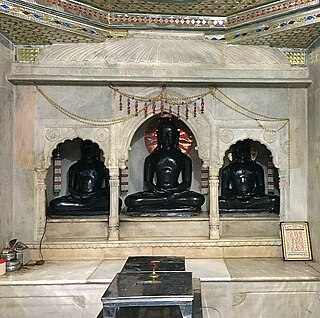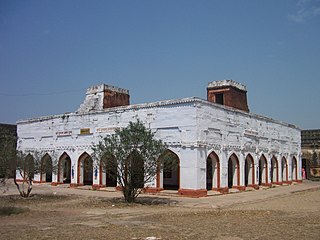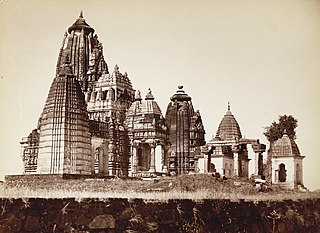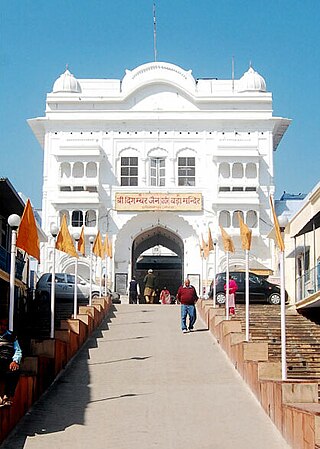
Tikamgarh is a town and a tehsil in Tikamgarh district in the Indian state of Madhya Pradesh. The city serves as a district headquarters. The earlier name of Tikamgarh was Tehri consisting of three hamlets, forming a rough triangle. In Tikamgarh town there is locality still known as 'Purani Tehri'. Until Indian independence in 1947, Tikamgarh, formerly called Tehri, was part of the kingdom of Orchha, which was founded in the 16th century by the Bundeli chief Rudra Pratap Singh, who became the first King of Orchha. In 1783 the capital of the state was moved to Tehri, about 40 miles (64 km) south of Orchha, which was home to the fort of Tikamgarh, and the town eventually took the name of the fort. The district is famous for the old fort of Kundar known as Garh Kundar, which was built by Khangars and remained the capital of Khangar rulers from 1180 to 1347.

Bundelkhand, a region in central India, has been an ancient center of Jainism. It covers northern part of Madhya Pradesh and south western part of Uttar Pradesh.
Shah is a common surname in India, Nepal, Bangladesh and Pakistan.

Jainism has been present in Maharashtra since ancient times. The famous Ellora Caves demonstrate that Jainism was part of a thriving religious culture in Maharashtra in premodern times.
Badnawar (or Badnavar) is a Town, former pargana and a Nagar Parishad of the Dhar district in the state of Madhya Pradesh, India. This is a tehsil place having 170 villages. Badnawar is around 95 km from Indore - the business capital of Madhya Pradesh.

Bhojpur is a town of historical and religious importance in Raisen District of Madhya Pradesh, India.

Parwar, also spelt as Paravāra, is a major Jain community from the Bundelkhand region, which is largely in Madhya Pradesh, but also includes the two districts of Lalitpur and Jhansi in Uttar Pradesh. Apart from them, Nagpur district (Maharashtra) have also a very large Parwar community. There is an area in Itwari of Nagpur known as Parwar-Pura having large number of Parwar's homes and shops. Most of the Nagpur's Parwar are migrated from Sagar, Deori, and other small villages of Sagar District of MP. Parwar exclusively follow the Digambar Jain tradition. Parwar usually preferred their marriage within community. There are 12 Gotra in Parwar community. Each Gotra has 12 Moor (lineages). A marriage within the same gotra or lineage are not allowed. Traditionally a marriage within any of the 8 branches was not permitted and hence the community was termed ashta-shakha.

Golapurva is an ancient Digambar Jain community from the Bundelkhand region of Madhya Pradesh.
Gahoi is a merchant Vaishya-Baniya community in central India.

The term Alha Khand is used to refer to poetic works in Hindi which consists of a number of ballads describing the brave acts of two 12th century Banaphar heroes, Alha and Udal, generals working for king Paramardi-Deva (Parmal) of Mahoba against Prithviraj Chauhan of Ajmer. The works has been entirely handed down by oral tradition and presently exists in many recensions, which differ from one another both in language and subject matter. The Bundeli, Bagheli, Awadhi, Bhojpuri, Maithili, and Kannauji recensions are the most well known among these.
Bahuriband, near Katni in Madhya Pradesh, is a famous inscription at the feet of a colossal stone image of Jain Tirthankara Shantinath. The colossal statue is 12 ft 2 in (3.71 m) in height.

The Jain temples of Khajuraho are a part of the UNESCO World Heritage Site of Khajuraho. They are located in Chhatarpur district, Madhya Pradesh, India, about 175 kilometres southeast of the city of Jhansi.
Nema is a merchant community which is mainly found in Madhya Pradesh. It has also spread to Gujarat and Rajasthan. It originated from the Nimar region of western Madhya Pradesh, where this community is still concentrated.

Uttar Pradesh, a state in north India has a long association with Jainism. Today the state is home to a number of Jain monuments, such as Jain Temples and Jain Tirths. There are around 213,267 Jains in Uttar Pradesh according to 2011 Census of India.

Paporaji, also called Pampapur, a temple site in Madhya Pradesh, India, 5 km east of Tikamgarh. The site is a center for the Jain religion. This is an atishaya kshetra, with 108 shrines.

Digamber Jain Prachin Bada Mandir is a Jain temple complex located in Hastinapur, Uttar Pradesh. It is the oldest Jain temple in Hastinapur dedicated to Shantinatha, the 16th Jain Tirthankara.

Shantinatha temple is a Jain temple located among the Jain temple cluster in eastern Khajuraho in Madhya Pradesh, India. While its main deity is the Jain tirthankara Shantinatha, it includes 18 shrines with numerous Jain images.

Aharji Jain Teerth is a historical pilgrimage site for Jainism located in Aharji, Madhya Pradesh, on the road from Tikamgarh to Chhatarpur.

Navagarh is a Jain Tirth in India. It is located at the Nabai village near Sojna in central India in Uttar Pradesh, just across the border from Madhya Pradesh. It is 65 km east from Lalitpur and 110 km north from Sagar. This ancient cite was excavated in 1959. It is the only tirth in India where the main deity is the ancient image of Lord Aranatha, preserved in the ancient underground chamber.















